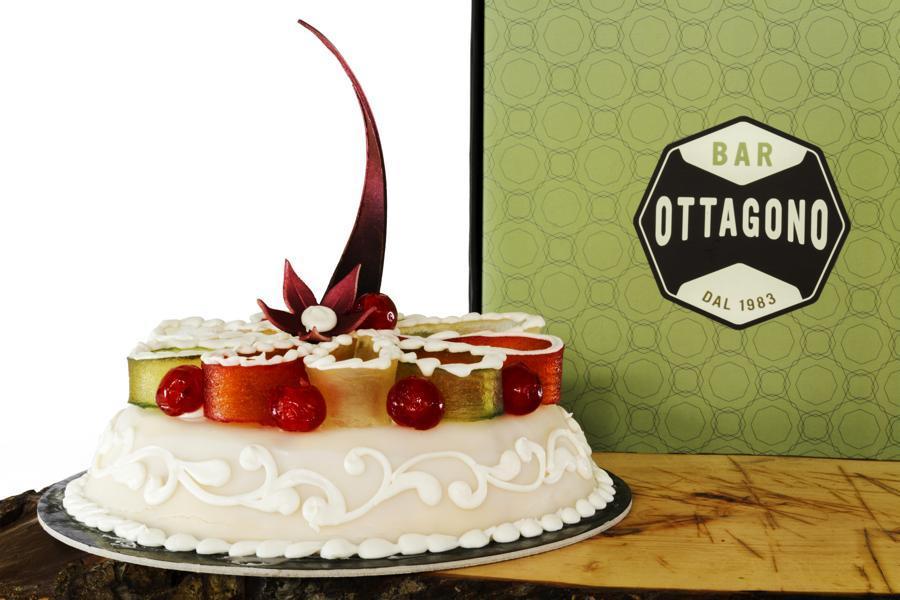The cassata

That our Sicily, an island of infinite contradictions, is a land, at the same time, bitter and duci is certainly not new; that, then, coffee is better to have sweetened because we already have this bitter life is another hard truth (although difficult to accept for those who would like to follow a strict diet), therefore ... why not focus (at least here) exclusively on the immeasurable , as well as reassuring, range of delicious ducezze that our island generously gives us?
Perhaps it is useless to pour out in bursts, right at the beginning of this greedy journey, the myriads of famous fruity smells and kneaded, toasted and baked fragrances that you will be able to encounter in this synesthetic journey, enriched by the secrets kept and matured by the Sicilian maternal tradition and from the historical curiosities that these jealously enclose. As they say, even from a culinary point of view: let's proceed "sparingly". Considering above all that it is a purely spontaneous and amateurish journey, destined to grow under the pushes and impulses suggested by the periods (festivals, holidays), by situations, by friends and by the unquestionable will dictated by the panza.
You will immediately notice that, in addition to the classic and revisited recipes, we will always add a pinch of history, folklore and curiosities to taste, perhaps deepening the beneficial properties of some ingredients, recommending places on the island where you can stuff yourself with the best desserts, or simply adding a healthy and poignant popular saying. Anything goes, as long as it's sweet.
So let's start. It may be trivial, however it would have been a crime not to start with and with her… the Queen and the quintessential symbol of Sicilian desserts:
Sicilian cassata
Cu 'nappi 'nappi de cassateddi easter…
The typical Sicilian traditional cake made with sheep's milk ricotta, sponge cake, marzipan, candied fruit and sugar icing, is so good because, just like its land of origin, it is the fruit (and sweet) of centuries of change and influences, including foreign ones.
Dulcis in fundo : The story. The roots of cassata date back to between the 9th and 11th centuries, when the Arabs introduced sugar cane, almonds, citron, lemon, bitter orange and mandarin to Palermo. These ingredients were added, in fact, fatally to the ricotta, which had already been produced in Sicily for some time. The origin of the name remains uncertain, according to a current of thought it derives from the Arabic qas'at , i.e. "basin" from the circular, cylindrical and flared saucepan in which it was and is still prepared today. According to others, however, the cake owes its name to the Latin caseum, "cheese", for obvious reasons. Initially it was simply a shortcrust pastry filled with ricotta and baked in the oven. However, when in the Norman period, around the end of the 1100s, at the Martorana convent in Palermo some nuns created marzipan, the very sweet dough made of almond flour and sugar, the latter replaced the shortcrust pastry as a wrapper. First great mutation: in fact, it passed from the baked cassata to the cold one. Together with the Spaniards, later, chocolate also arrived and, precisely, the sponge cake. These last ingredients married so well with the cassata recipe that they can never be missing again. Last touch: the Baroque. The opulent and sumptuous style of the seventeenth century threw itself headlong into the soft dough of our cassata to embellish it with rich candied fruit decorations. In reality, the external appearance of the cake varies a lot, and can go from a simple icing decoration with a little candied orange peel, to the baroque construction with which most of the time it is represented.
Tasty Curiosities
- Due to its shape and its often orange colours, the cassata is considered a symbol of the sun and of life which therefore ideally places it as a dessert for the feast of
- According to local variants there may be additional ingredients, such as pistachio, pine nuts, chocolate, cinnamon, maraschino or orange blossom water.
- An official document of a synod of Sicilian bishops in Mazara del Vallo, in 1575, states that the cassata is "indispensable during the holidays".
- Today's Sicilian Cassata was created by a pastry chef, Cavaliere Salvatore Gulì, whose pastry shop was located in Corso Vittorio Emanuele, near Palazzo Belmonte. The cake was exhibited for the first time at an exhibition in Vienna in 1873 .
"Dulcis in furno": Recipe (tell me which one you prefer or add yourself if you want)
Here is the recipe divided into various parts to make the procedure clearer.
Ingredients for 4 people
For the ricotta filling:
500 grams of very fresh sheep ricotta
300 grams of sugar
50 grams of chocolate chips
1 sachet of vanillin
Procedure: Keep the fresh sheep's ricotta in the fridge at least one night before working it so that it loses the whey. Add the sugar and vanillin to the fresh, dry ricotta and mix everything together, then leave it to rest for about an hour. Then sift the mixture until you obtain a soft and smooth cream to which you can add the chocolate chips.
For the marzipan:
250 grams of almond flour
250 grams of granulated sugar
150 grams of water
Green food coloring
Procedure: In a saucepan, dissolve the sugar in the water over low heat, stirring constantly. As soon as the sugar starts to run, pour in the almond flour and add the colouring. Keep stirring and pour onto a wet marble surface where you can leave the mixture to cool. Then work with your hands until you get a soft and smooth dough. Then roll out the dough with a rolling pin until it reaches a thickness of 8 mm, cut into rectangles about 6 cm wide and the same height as the edge of the mould.
For the sponge cake:
75 grams of flour
75 grams of potato starch
A pinch of salt
5 eggs
1 sachet of vanillin
150 grams of granulated sugar
Procedure: Divide the egg whites from the yolks into two bowls; then beat the egg yolks with half the sugar with the help of an electric mixer until you obtain a creamy, light yellow mixture. Whip the egg whites until stiff and then add the other sugar. Continue assembling. Add the whipped egg whites to the yolks and mix everything well. Add the flour, vanillin and sifted potato starch to the liquid parts. Mix everything well until you get a homogeneous mixture. Grease and flour a baking tray and pour the mixture. Preheat the oven and bake for about 40 minutes at 180°. Search not to open the oven during cooking, because the compote could deflate. Check the cooking with a toothpick, remove the pan and let it cool.
For the sugar glaze:
150 grams of sugar
1 ladle of water
Procedure: Dissolve the sugar in the water over low heat until it becomes stringy and transparent. Prepare the glaze just before you need it as it should be poured while still hot.
Final composition of the cassata
base of sponge cake
Mixed candied fruit
Water to taste
Procedure: First of all, equip yourself with a round cassata mold with flared edges. Then divide the sponge cake base into three equal disks and place one on the bottom of the mould. Dissolve the sugar in the water and moisten the sponge cake. From another disc of sponge cake, cut rectangles of the same size as those prepared with marzipan, then place them on the edge of the mold, alternating them. Pour the ricotta cream into the mold and cover everything with the remaining sponge cake, leaving it to rest for an hour. At this point it will be possible to turn the cassata upside down on a round tray and cover with the freshly prepared icing sugar. Be careful to spread the icing well even on the edges so as to cover it entirely, and let it cool again. After decorate as desired with candied fruit and serve.
or
Ingredients for 4 people
1 disc of about 500 gr. of sponge cake
700 g. of fresh ricotta
400 g. of sugar
1/2 teaspoon of vanilla essence
100 g. of candied orange peel
100 g. of dark chocolate drops
300ml of water
200 g. of icing sugar
1/2 glass of Marsala
For the finish
250 g. of almond paste
Marzipan to taste
Mixed candied fruit
For the glaze
300 g of icing sugar for garnish
180ml of cold water
Preparation: Slice the sponge cake disc into thin slices and cover a pan of about 24 centimeters in diameter covered with a plastic sheet, carefully covering the bottom and edges. To make the filling, sift the ricotta. Mix it with the sugar and vanilla, possibly adding a little milk if the mixture is too hard. Then add the candied orange peel, cut into small pieces, and the chocolate chips. Then mix the ingredients until they are blended and pour the ricotta mixture into the pan with the sponge cake. Then cover the filling with other slices of sponge cake. Meanwhile, in a saucepan, dissolve the 200 g of icing sugar with 300 ml of warm water, leaving the mixture to cool before adding the Marsala. Use this mixture to gradually wet the slices of sponge cake. Finally, place the cassata in the refrigerator and let it rest overnight. The following day, carefully unmold the cassata and arrange it on a serving plate. Then soften the marzipan in your hands before reducing it to a sheet of about 5 mm thick. Cut it out using the cassata pan, now empty, as a guide and cover the cassata with the marzipan disc and other strips of marzipan to cover the edges. To make the glaze, bring the cold water together with the powdered sugar to a boil. Turn the heat down to low and stir constantly until the sugar is completely dissolved (3-5 minutes). Pour it immediately on the cake and distribute it evenly with a wet spatula. Decorate the cassata with candied fruit of your choice. And get rich!
Let's go deeper
Ricotta: The winning ingredient of this first study could only be ricotta. Perhaps it will be of little interest to us to know that it is incorrectly defined as cheese, because in reality it is a dairy product obtained from whey and not from curd, because whatever it is is really good. However, we will be more interested in knowing that it is an extremely complete food containing many mineral salts and proteins and that it is essential that it is eaten very fresh since it is not able to withstand the attack of microorganisms, which would therefore make it inedible. The ricotta proteins are one of the strengths of this dairy product. In fact, they have an extremely higher biological value than both cheese and meat. We will then be interested in discovering that although in terms of calories, it certainly cannot be considered as a fatty product, one must be careful of the type of preparation as this affects the calorie intake. In fact, milk and cream are often added, making it heavier. Finally, let us remember that ricotta is an extremely versatile ingredient in the kitchen, we can use it to make bread but also cakes, for sweet and savory recipes. Therefore, for desserts, cakes and first courses, which are quite high in calories, it will be good to choose a low-calorie ricotta and, if artisanal, perhaps opt for the whey-only one.






Leave a comment